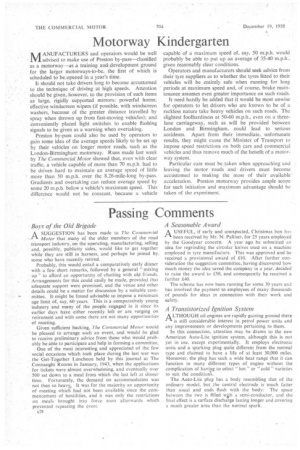Motorway Kindergarten
Page 30

If you've noticed an error in this article please click here to report it so we can fix it.
MANUFACTURERS and operators would be well advised to make use of Preston by-pass—classified as a motorway—as a training and development ground for the larger motorways-to-be, the first of which is scheduled to be,opened in a year's time.
It should not take drivers long to become accustomed to the technique of driving at high speeds. Attention should be given, however, to the provision of such items as large, rigidly supported mirrors: powerful horns: effective windscreen wipers (if possible, with windscreen washers, because of the greater distance travelled by spray when thrown up from fast-moving vehicles): and conveniently placed light switches to enable flashing signals to be given as a warning when overtaking.
Preston by-pass could also be used by operators to gain some idea of the average speeds likely to be set up by their vehicles on longer motor roads, such as the London-Birmingham motorway. Runs made last week by The Commercial Motor showed that, even with clear traffic, a vehicle capable of more than 70 m.p.h. had to be driven hard to maintain an average speed of little more than 50 m.p.h. over the 8.26-mile-tong by-pass. Gradients and overtaking can reduce average speed by some 20 m.p.h. below a vehicle's maximum speed. This difference would not be constant, because a vehicle capable of a maximum speed of, say, 50 m.p.h. would probably be able to put up an average of 35-40 m.p.h., given reasonably clear conditions.
Operators and manufacturers should seek advice from their tyre suppliers as to whether the tyres fitted to their vehicles will be entirely safe when running for long periods at maximum speed and, of course, brake maintenance assumes even greater importance on such roads.
It need hardly be added that it would be most unwise for operators to let drivers who are known to be of a reckless nature take heavy vehicles on such roads. The slightest foolhardiness at 50-60 m.p.h., even on a threelane carriageway, such as will be provided between London and Birmingham, could lead to serious accidents. Apart from their immediate, unfortunate results, they might cause the Minister of Transport to impose speed restrictions on both cars and commercial vehicles and thus remove much of the benefit of a motorway system.
Particular care must betaken when approaching and leaving the motor roads and drivers must become accustomed to making the most of their available acceleration. Preston .motorway provides ample scope for such initiation and maximum advantage should be taken of the experiment.




































































































